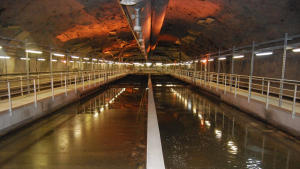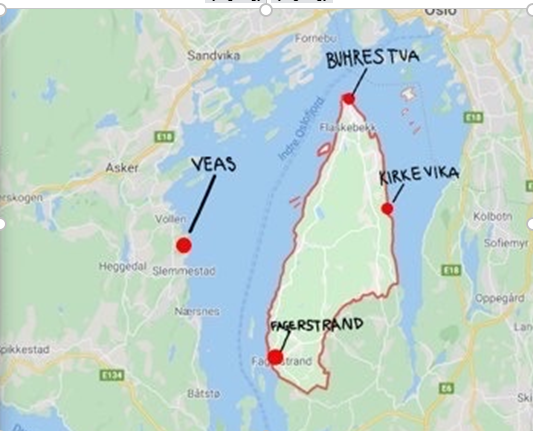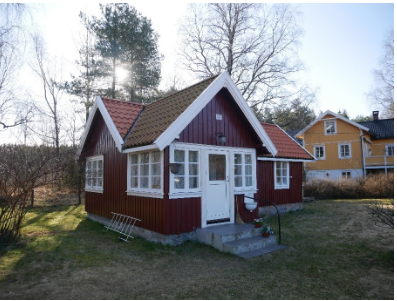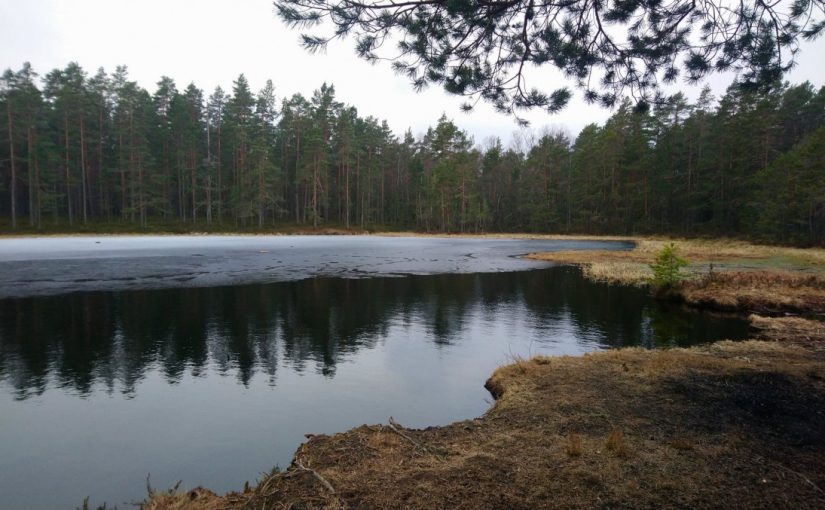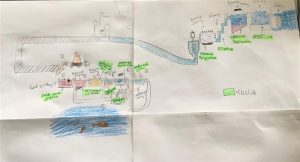
Category: Drainage and Waste Water
An article on the local sewer system on Nesodden
By: Mattis and Elias

On Nesodden, we have both private and public sewer systems. Most of the houses in Nesodden are a part of a public sewer system. There are three different sewer systems in Nesodden, and each of them relates to its own part of Nesodden. For example, the place around our school relates to one sewer system, and another area in our municipality is related to another sewer system.
One of the sewer systems does not satisfy the daily request as a sewer system, so there are going to be placed sewer pipes under the fjord to a place called Asker, where there is a bigger sewer system. The sewer from the sewer system that does not satisfy the daily request, are then going to be transported under the fjord to the system in Asker.
We in our group wanted to find out more about details of the sewer system in our municipality, so we had an interview with a man in “Nesodden Sewer”. There we asked him some questions we were wondering about.
The interview we had:
Is the sewer in Nesodden dangerous for the nature and the ecosystem with thoughts on the chemical content?
The sewer is not dangerous for the environment as long it’s not going unclean out in the nature. Almost all the wastewater at Nesodden is going under the ground in pipes before it gets cleaned at the treatment plant. After that it is released into the water. Unclean wastewater contains many dangerous materials for humans, plants and animals, but it contains also good nutrients like phosphor. Phosphor is used at the landmarks for the plants and corn to make them grow faster (that is why the harvesters uses cow poop at their fields). If we release the wastewater into a lake, then it will be a massive algae growth. Algae uses the oxygen in the water so other organism dies of oxygen loss. (Fish, crabs and other animals in the water. That’s why we don’t throw wastewater in the nature.
Are there any challenges with the sewer in Nesodden?
The sewer is not dangerous for the environment as long it’s not going unclean out in the nature. Almost all the wastewater in Nesodden, is going under the ground in pipes before it gets to the cleaned at the treatment plant before it gets dropped out. Unclean wastewater contains many dangerous materials for humans, plants and animals, but it contains also good nutrients like, among other things, phosphorus. Phosphorus is used in the farming for the plants and corn to make them grow faster (that is why farmers use cow poop at their fields). If we release the wastewater into a lake, then it will be a massive alga growth.
Alga uses the oxygen in the water so other organism dies of oxygen loss (fish, crabs and other animals in the water). That’s why we don’t throw wastewater in the nature.
Are there any big differences between how the sewer system in Nesodden and other places run?
Sewage treatment in Norway operates just like many other countries. The treatment requirements could vary but it is almost the same. The thing that separate the water treatment in different places, is the emission point for the clean wastewater. If you release clean wastewater into a small lake, the requirements will be bigger. Some of the normal requirements is about the amount of phosphorus you can release into the water/lake.
What kind of chemical materials is there in the sewer of Nesodden?
Sewer contains mostly nutrients, organic materials and microorganism. There are also many rests from medicines, lard and many other things that doesn’t get dissolved. Many things in our sewer isn’t meant to be there.
Do the sewer and the drinking water on Nesodden have something in common?
Absolutely! The sewer contains 97% clean drinking water from showers, sinks and toilets.
How can the sewer affect the groundwater, freshwater and the fjord around Nesodden?
If we have a sewer leak in one of our pipes, then this will flow down to the ground and soon this will hit the groundwater. Some of the houses with drinking water from the groundwater will then be exposed for polluted drinking water if there is a leak in a pipe. When it’s about lakes and seas, then there is, as I said over, growth og algae and different organic materials will lead to oxygen lack.
A picture of how the new sewer system I going to be:
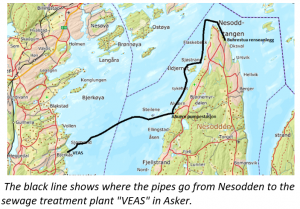
The black line is the sewer pipes that is going to be placed under the fjord. “Buhrestua renseanlegg” is the name of the sewer system that doesn’t satisfy the daily request.
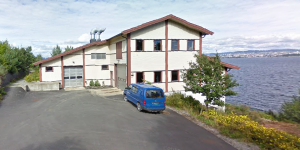
|


Veas sewer system does also produce fertilizer from the rests of the sewer.
Sewage and drainage
By Yngve, Jonathan and Vilmer
A Natural science/social science assignment week 11-14
Sewage and drains
Wastewater and sewage water are most often passed through pipes and sewages under the ground. These pipes are often extended far beyond built up areas. The wastewater consists of liquid waste from different houses and blocks around a city or a village. And sewers consist of feces, urine and sometimes waste (like plastic and etcetera). Usually all municipalities have different municipal drains where pipes lead the wastewater to sewage treatment plants around the city. Then, after the treatment the wastewater is clean and released into the ocean as perfectly clean water.
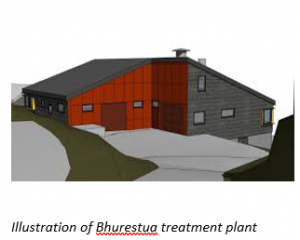
Wastewater treatment plans and where they are located
Nesodden has three municipal treatment plants, these three treatment plants take ca re of, and are located at Tangen, Fagerstrand and Kirkevika. The treatment plant at kirkevika does not fulfil today’s requirements on how a treatment plants should be and work, which is why VEAS plans to launch or substitute a new treatment plant nearby. The treatment plans for Fjellstrand, Bjørnemyr and Alværn are not located on Nesodden. The treatment plans for Fjellstrand, Bjørnemyr and Alværn are in Asker. The sewage water from these three areas is led to Asker through underwater pipes in Oslofjorden.
re of, and are located at Tangen, Fagerstrand and Kirkevika. The treatment plant at kirkevika does not fulfil today’s requirements on how a treatment plants should be and work, which is why VEAS plans to launch or substitute a new treatment plant nearby. The treatment plans for Fjellstrand, Bjørnemyr and Alværn are not located on Nesodden. The treatment plans for Fjellstrand, Bjørnemyr and Alværn are in Asker. The sewage water from these three areas is led to Asker through underwater pipes in Oslofjorden.
If municipal crisis where to happen
The local drinking-water in Nesodden is safe to drink and it has a very good hygienic quality. Eurofins (accredited laboratory) executes all kinds of analyses on our water tests. If any mistake is discovered on the tests they take, the community will be reminded immediately from the laboratories. When it has been forwarded to the community, the leaders here in Nesodden will message all the inhabitants (via SMS on mobiles) that there is something wrong with the drinking water. If this case is critical, the community will send out a few advices which are wise to follow. If anyone would like more information during one of these situations, updated info will be posted on the community’s website. So, if a leak happens in the drinking-water or the sewer the inhabitants and the town’s population will be updated regarding what has happened very quickly. If a leak were to happen, VEAS would also send out people to inspect and examine some reasons behind the leak.
Sewage and drain
By Mai and Thea
We have three municipal wastewater treatment plants on Nesodden. Some parts of Nesoddens drain go through Asker and the wastewater treatment plants in Asker is called VEAS. Here is a map over Nesodden and our municipal wastewater treatment plants.
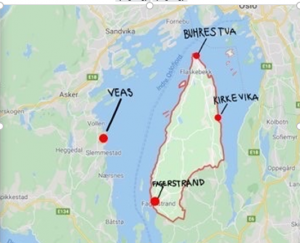
foto: https://www.google.com/maps/place/Nesodden/@59.8031905,10.5029789,11z/data=!3m1!4b1!4m5!3m4!1s0x46416a150e58a893:0x569d6d19a0be0fcf!8m2!3d59.8042819!4d10.6381967?hl=no
VEAS is a company in Asker, a town nearby Nesodden, as you can see on the map above. Nesodden is the light area that is marked with red. The wastewater from some places at Nesodden get cleansed there. At first, the wastewater gets sucked up from an inlet pump station that lies 23 m underground. Here the garbage is removed from the water, usually its q-tip and plastic. To remove phosphor and other organic substances, chemicals are added. The chemicals cause the small particles to bond with bigger particles, so they sink to the bottom and makes something that is called slam. This is easy to remove from the water instead of the small particles, that’s nearly impossible to just remove. The wastewater gets collected in a treatment plant where they rinse the water from toxic pollution that may be in the water. The purified water is discharged to the nearest sea or river.
Private Water and Drainage
By Agnes and Thomas
Around 2000 properties on Nesodden are not connected to the public (municipal) system for water and drainage. Most of these get their water from a well and has a private drainage solution, such as a septic tank.
In 2008, the municipality checked 988 private wastewater treatment plants, and found out that 80% of these needed ugrading to comply to the Pollution Regulation requirements. Samples were also taken from many wells, where only 23% had a water quality that satisfied the drinking water regulation.
The local government want everybody to be connected to the public system for water and drainage. Sadly, that is not feasible now. Many people want to connect to the public system, because the public water often is better, and the draining system is safer, cleaner and more hygienic. But it is expensive and time consuming and getting everyone on the public water systems is not a high priority by the municipality.
Thomas uncle who has privat water lives in an area where municipal water is not available. And Because they dont have municipal water, they receive water from the well. The water goes through a treatment plant, so the water is as clean as the municipal water.
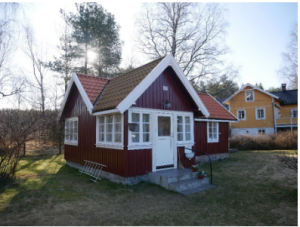
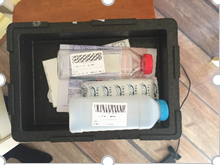
Where Agnes lives it was different. The water got tested last year and contained many minerals, such as iron, manganese, magnesium, calcium and natron. These minerals aren’t that bad themselves, but the water also contained intestinal bacteria, such as e. coli and coliform, since the well has been to open.
When we found out that the water wasn’t drinkable, we wanted to fix that. We protected the well better, so the water would stay fresh. Last week, we tested the water again. I filled bottles with our tap water and sent them to a laboratory. This is how the testing kit looked:
We got the test results back this week, and it turns out our water is clean for intestinal bacteria! The water still contains heavy metals, so we won`t drink so much of it, but still use it for cooking, washing and brushing our teeth.
How does our Water and Drainage system work on our peninsula, Nesodden?
This article is written by Casper, Kristine, Tonje, Emma and Sofia GH.
We are going to tell you a bit about how our council mangage our water waste, drains and sewage on Nesodden. How is it handled, and are there any problems and challenges connected with it.
What is wastewater and sewage?
Wastewater is sewage, rainwater and more that is coming from households, and gets transported underground in pipes. Wastewater is water that is degraded in quality (contaminated) due to the influence of man-made processes.

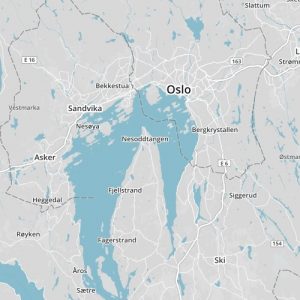
Sewage and drains on Nesodden
On Nesodden, there are three different sewage treatment plants, but one of them doesn´t meet the requirements. About 2000 properties aren´t connected to public water and drains, but some people have private sewer systems. Many of them are old, and may pollute the groundwater, private drinking water wells and streams and lakes.
Almost all drains on Nesodden are getting transported in pipes underground. Some houses aren´t connected to the sewage system because houses are scattered. And it is too expensive to connect to the system. Therefore, not all sewage is transported to the sewage treatment plants.
Have sewage and drains created problems on Nesodden?
Sewage and drains do not cause problems by themselves. What causes problems is that people throw products in the toilet that do not belong in the drain. For example, they throw wet wipes, cotton buds, food waste, grease and much more. Wet wipes do not dissolve, they stick to the pumps, so they clog and are blocked. Cotton buds do not dissolve and block pipes and pumps. Food waste becomes food for rats living in the sewage pipes. Many rats lead to blocked drainage pipes. Grease is thin liquid in warm water, but it solidifies when it meets cold water. People throw a lot of weird stuff in the toilet, there are problems with pumps and drains almost every day. This is expensive for Nesodden.
Maintenance and progress work of drain pipes
The existing drain system has stayed unchanged for many years. However, new changes and materials have made it better now. A while ago we had wooden pipes. They made some problems because they rotted. Now we have plastic pipes which are stronger.
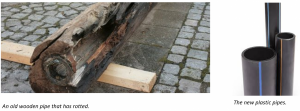
In the future, all wastewater on Nesodden will be pumped over to VEAS (a sewage treatment plant in across the fjord in Asker, se map). Now, people are laying pipes across the water from the west side of our peninsula, Alværn to Asker.

Summary
The sewage at Nesodden being transported through plastic pipes to the sewage treatment plants across the fjord from where we live. At Nesodden we have three, but many houses aren’t connected to them. The problems with sewage and drains are when people throw garbage in the toilet instead of the trash can.
Our sources:
https://www.nesodden.kommune.no/vei-vann/vann-og-avlop/kommunale-avlopstjenester/ (23.3.2020)
https://www.nesodden.kommune.no/vei-vann/vann-og-avlop/ (23.3.2020)
https://www.nesodden.kommune.no/vei-vann/vann-og-avlop/tilkobling-offentlig-vann-og-avlopsnett/ (23.3.2020)
Jon Petter Johnsen (Project Manager at Nesodden)


